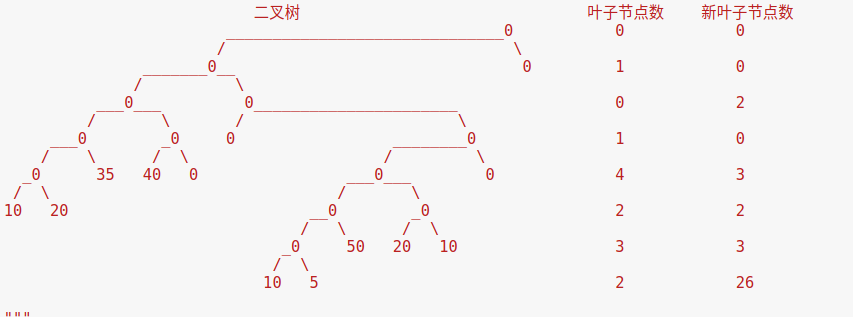二叉树优化问题 | Python 实战
唠唠闲话
同学项目里的一道问题,表述简单且不需要什么理论背景。
本篇介绍用 Python 写的处理这一问题的工具,内容如下:
二叉树优化问题
下边涉及的二叉树都要求满足性质:每个节点要么有两个子节点,要么没有子节点。
-
给定二叉树,通过统计每行叶节点数目,得叶节点序列,如图

-
给定新的叶节点序列,对二叉树做以下操作,使叶子节点数满足新序列:
- 将节点与其所有子节点合并,操作开销为其子叶节点数值之和
- 将叶节点展开,操作开销为叶节点的数值
-
求满足要求的最小开销和操作。
使用演示
下载仓库,在目录下运行 Python
1 | git clone git@github.com:RexWzh/binary_tree.git |
示例
-
导入模块
1
from btree import *
-
输入初始树和叶节点信息
1
2
3
4
5
6
7n = 8
positions = [None for i in range(2**n-1)] # 旧树
pos = [1, 2,3, 4,5, 8,9,10,11, 16,17,18,19,22, 23,32,33,44,45, 88,89,90,91, 176,177]
value = [0, 0,0, 0,0, 0,0,0,0, 0,35,40,0,0, 0,10,20,0,0, 0,50,20,10, 10,5]
for p,v in zip(pos,value):
positions[p-1] = v
leaves = [0,0,2,0,3,2,3,26] -
运行主函数
main,并打印计算结果1
2
3
4
5optimal,cost = main(positions,leaves)
print("操作开销",cost)
old = list_to_tree(positions)
sep,com = get_operations(old,optimal)
print("拆开位置",sep,"合并位置",com)显示如下
1
2操作开销 0
拆开位置 {19, 10, 3} 合并位置 set()
算法及测试
算法用 BFS 遍历, Python 编写,步骤参看 main 函数代码。
关键函数 next_level :“树 -> 增加一层节点的树集” 。
next_level 工作内容:
- 获取
tree的最后一层节点last_layer - 将节点分三类,优先展开(sep),尽量不展开(not_sep)和随便(whatever)
- 从
last_layer里取ak个节点展开,每种取法得一棵新树 - 利用三类节点信息,减少选取可能并记录开销
- 返回值:添加一层节点的新树,并判断是否已到最后一层
main 函数:
1 | def main(positions,leaves): |
随机测试
随机生成叶子序列,测试运行速度,初始树同上。
1 | import time |
计算 1000 个数据,用时 1.520s。速度较慢但还能接受。慢主要因为类编程占用更多内存,用类实现方便但过程比较绕。如果直接对列表操作可以加快,但这没必要了,因为算法本身也有缺陷。
坏情况测试
当初始树或叶子序列有一方性质好时,计算时间短。但如果初始树和序列都取到坏情况,运行就吃力了。
-
坏情形的初始树
1
2n = 8
positions = [0]*(2**(n-1)-1) + list(range(2**(n-1))) -
配合性质稍差的叶子序列
[0, 1, 0, 0, 5, 2, 5, 6]1
2
3
4
5
6
7
8leaves = [0, 1, 0, 0, 5, 2, 5, 6] # 18 秒
t = time.time()
optimal,cost = main(positions,leaves)
print("计算用时 %.3fs"%(time.time()-t))
print("操作开销",cost)
old = list_to_tree(positions)
sep,com = get_operations(old,optimal)
print("拆开位置",sep,"合并位置",com) -
运行结果
- 计算用时 18.280s
- 操作开销 7381
- 拆开位置 set()
- 合并位置 {121, 2, 58, 122, 59, 123, 120, 124, 24, 25, 26, 27, 28}
计算已经开始勉强了,如果考虑最坏情形的叶子序列 [0, 0, 0, 0, 0, 6, 26, 52],这个算法就完全不能用了。
写在后边
图论问题用穷举容易碰壁,这次限定了 8 层,刚开始觉得可以穷举,就写了算法。
但直到代码实现,做随机测试才发现算法不能通用。
总结:尝试算法前先分析复杂度,真正确定可以了,再落实到代码实现层面。
文章采用 CC BY-NC-SA 4.0 许可协议,转载请注明来自 学习乐园!
评论







